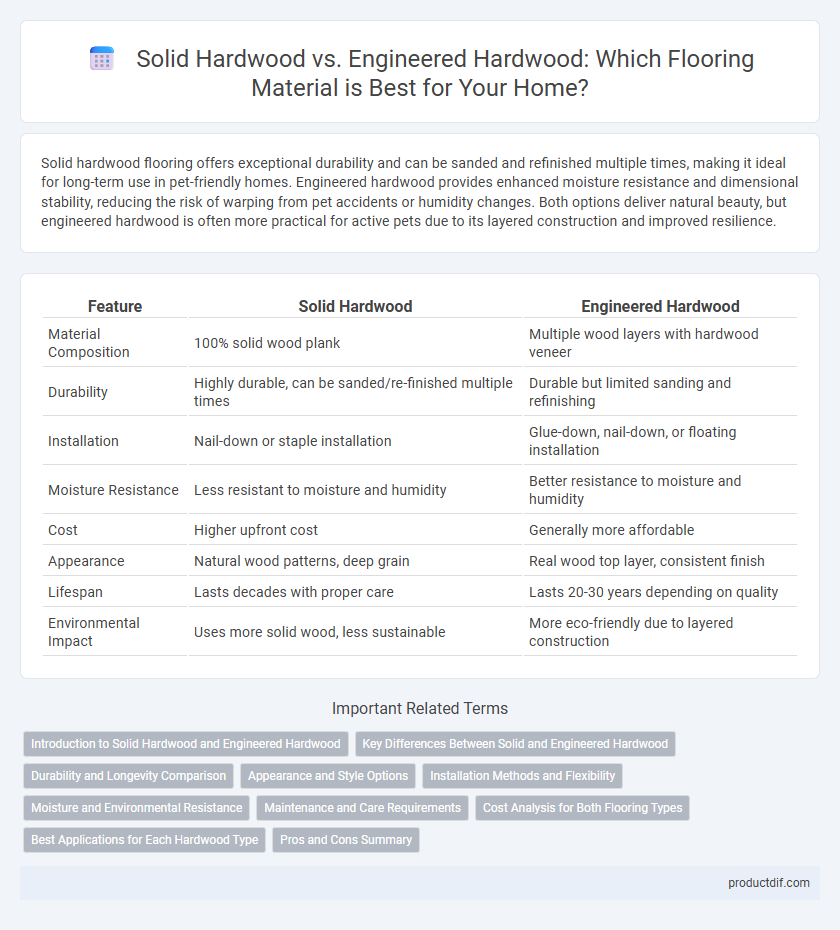Solid hardwood flooring offers exceptional durability and can be sanded and refinished multiple times, making it ideal for long-term use in pet-friendly homes. Engineered hardwood provides enhanced moisture resistance and dimensional stability, reducing the risk of warping from pet accidents or humidity changes. Both options deliver natural beauty, but engineered hardwood is often more practical for active pets due to its layered construction and improved resilience.
Table of Comparison
| Feature | Solid Hardwood | Engineered Hardwood |
|---|---|---|
| Material Composition | 100% solid wood plank | Multiple wood layers with hardwood veneer |
| Durability | Highly durable, can be sanded/re-finished multiple times | Durable but limited sanding and refinishing |
| Installation | Nail-down or staple installation | Glue-down, nail-down, or floating installation |
| Moisture Resistance | Less resistant to moisture and humidity | Better resistance to moisture and humidity |
| Cost | Higher upfront cost | Generally more affordable |
| Appearance | Natural wood patterns, deep grain | Real wood top layer, consistent finish |
| Lifespan | Lasts decades with proper care | Lasts 20-30 years depending on quality |
| Environmental Impact | Uses more solid wood, less sustainable | More eco-friendly due to layered construction |
Introduction to Solid Hardwood and Engineered Hardwood
Solid hardwood flooring is crafted from a single piece of natural wood, offering durability and the ability to be refinished multiple times to maintain its appearance. Engineered hardwood consists of a core of plywood or high-density fiberboard layered with a hardwood veneer, providing enhanced stability against moisture and temperature changes. Both options deliver authentic wood aesthetics, but engineered hardwood is better suited for areas with fluctuating humidity levels.
Key Differences Between Solid and Engineered Hardwood
Solid hardwood consists of a single piece of natural wood, offering greater durability and the ability to be sanded and refinished multiple times. Engineered hardwood features a plywood base with a thin veneer of real wood on top, providing enhanced stability and resistance to moisture and temperature changes. The choice between solid and engineered hardwood often depends on installation location, with engineered hardwood preferred for basements and areas with fluctuating humidity.
Durability and Longevity Comparison
Solid hardwood offers superior durability due to its dense construction and ability to be sanded and refinished multiple times, extending its lifespan well beyond 50 years with proper maintenance. Engineered hardwood features a plywood core layered beneath a veneer of real hardwood, providing enhanced resistance to moisture and temperature fluctuations, making it more stable in environments prone to humidity and temperature changes. While engineered hardwood may have a shorter lifespan of 20-30 years, its structural stability and moisture resistance often result in longer durability in basements or over radiant heating compared to solid hardwood.
Appearance and Style Options
Solid hardwood flooring offers a rich, natural grain and deep color variations that develop a unique patina over time, enhancing its classic and timeless appeal. Engineered hardwood provides a wide array of finishes, wood species, and plank sizes, allowing for versatile design choices that mimic the look of solid wood while accommodating modern aesthetic trends. Both flooring types deliver authentic wood textures, but engineered hardwood's layered construction enables more consistent appearance across diverse environmental conditions.
Installation Methods and Flexibility
Solid hardwood flooring requires nail-down or staple-down installation, making it suitable for wood subfloors but less flexible for below-grade or concrete installations. Engineered hardwood offers versatile installation options including floating, glue-down, and nail-down methods, allowing use over concrete slabs and radiant heating systems. This flexibility makes engineered hardwood a preferred choice for basements and areas with varying moisture levels.
Moisture and Environmental Resistance
Solid hardwood flooring offers natural durability but is highly susceptible to moisture, which can cause warping and swelling over time. Engineered hardwood features a plywood core that enhances dimensional stability, making it more resistant to humidity and temperature fluctuations. This construction allows engineered hardwood to perform better in basements or areas with higher moisture levels compared to solid hardwood.
Maintenance and Care Requirements
Solid hardwood flooring requires regular sweeping and occasional refinishing to maintain its appearance, as it is susceptible to scratches and moisture damage. Engineered hardwood offers greater resistance to humidity and temperature changes, making it easier to clean with damp mopping and less prone to warping. Both types benefit from protective measures like area rugs and felt pads on furniture to extend their lifespan.
Cost Analysis for Both Flooring Types
Solid hardwood flooring typically costs between $8 to $15 per square foot, offering long-term durability but requiring higher installation expenses due to its weight and craftsmanship. Engineered hardwood ranges from $5 to $12 per square foot, providing a more budget-friendly option with easier installation and better moisture resistance, making it suitable for basements or high-humidity areas. When factoring in maintenance and lifespan, solid hardwood may have higher upfront costs but often yields greater value over time compared to engineered hardwood.
Best Applications for Each Hardwood Type
Solid hardwood flooring is ideal for rooms with stable humidity levels such as living rooms and bedrooms, providing durability and the ability to be refinished multiple times. Engineered hardwood performs best in areas prone to moisture fluctuations, like basements and kitchens, due to its multi-layer construction that resists warping. Both types offer aesthetic beauty, but selecting the right material depends on the specific environmental conditions and use cases within the home.
Pros and Cons Summary
Solid hardwood offers durability, the ability to be sanded and refinished multiple times, and a classic, timeless appearance, making it ideal for long-term investment. Engineered hardwood provides better resistance to moisture and temperature changes, is easier to install over concrete or radiant heating systems, and is typically more affordable. However, engineered hardwood has limited refinishing options, while solid hardwood is more susceptible to warping in humid environments.
Solid Hardwood vs Engineered Hardwood Infographic

 productdif.com
productdif.com